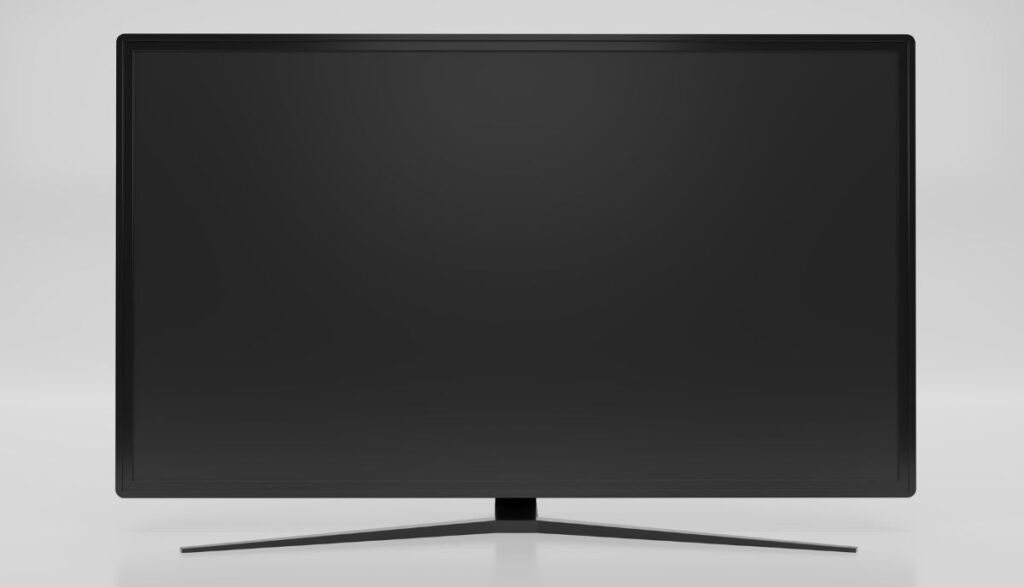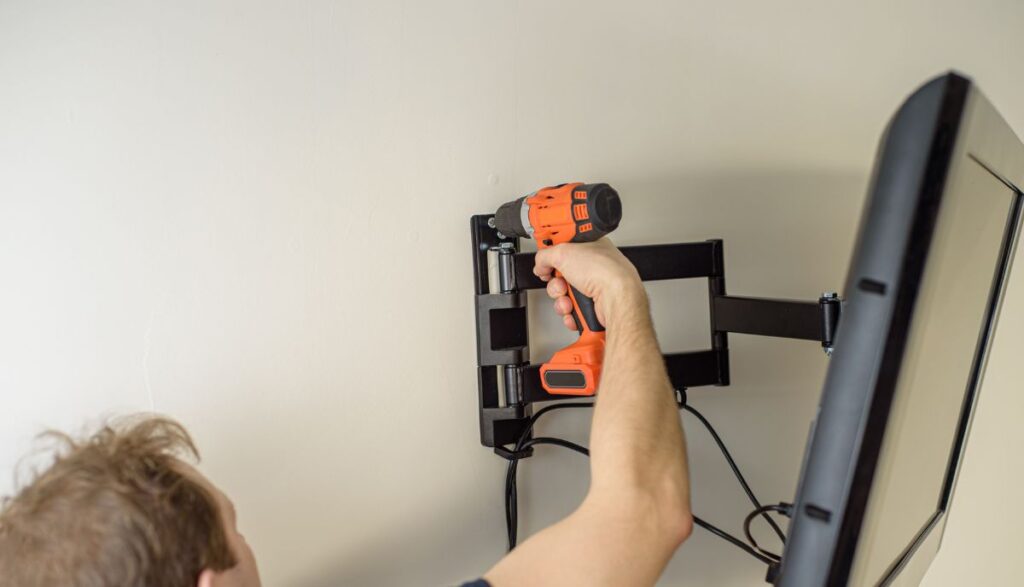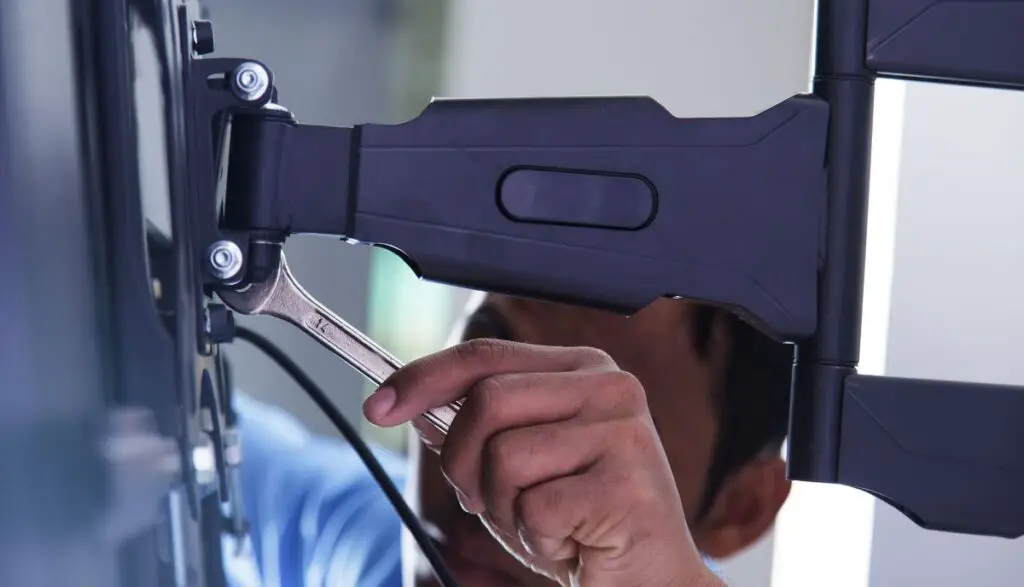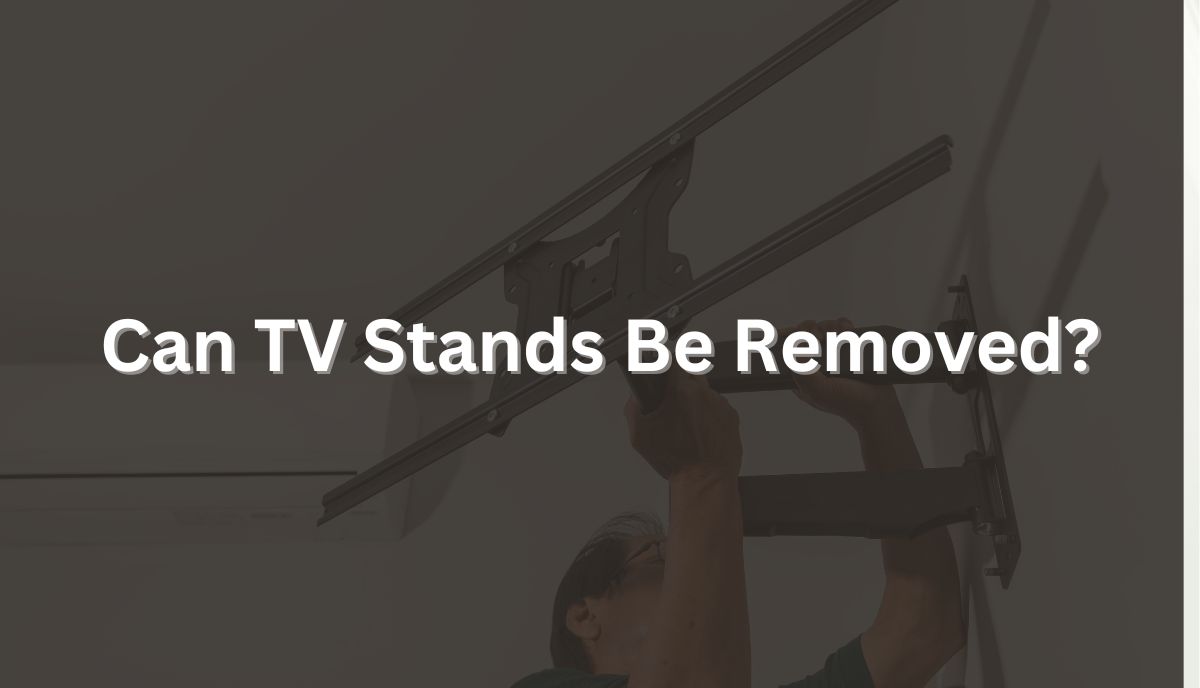Yes, TV stands can typically be removed. The process varies based on the type of stand, but generally involves detaching the TV, unscrewing the wall fixture, and patching any holes in the wall if needed. Safety precautions are advised for larger TVs.
TV stands are not all the same. You can find them in the following types:
- Corner
This type has an angled shape that fits in a corner. It includes additional shelves and cabins for books, consoles, vases, and the like.
- Open Shelving
This is a set of exposed shelves. They are called ‘Open’ because they don’t include closed cabinets.
- Console
This type is rectangular. It includes closed shelves and abundant surface areas. You can place a TV on top and additional items in the shelves and cabinets.
- Audio Towers
This type includes a mounting fixture in the middle and tall shelves on either side. The speakers and supplemental devices sit in the side shelves.
- Hutch
This type includes a built-in space for the TV and overhead shelves and cabinets.
- Cabinet
This is a series of cabinets. You can keep the electronics in the cabinets. The TV sits on top.
- Swivel
The curated Interior has a picture of the swivel stand. This type is not common in residential settings. The stand can rotate to accommodate various viewing angles.
- Floating
Here, you mount the TV on the wall, several inches from the ground. The option is appealing because it creates a sleek look. The name comes from the fact that the TV appears to float on the wall.
Home Stratosphere has a picture of a floating TV with shelves beneath, also attached to the wall and holding DVDs.
- Entertaining Center
Here, you have a comprehensive piece of furniture with multiple shelves and storage spaces. The TV sits at the center. You have cabinets below and shelves all around.
Among these options, the floating style is the only one that requires installation and removal. The others are pieces of furniture. You can buy them from a store and move them to your home, or an expert can purchase the material and construct the stands in your home.
This usually happens for entertaining centers that are too big to pass through your home’s doorway. If you have a floating-style TV stand, you can remove it. This is true for any stand you install.
Some wooden TV stands allow users to attach a mounting system and a TV on top. The diagrams in this Sony Guide show a TV attached with screws to a stand below.
Are TV Stands Typically Detachable Or Permanent Fixtures?

TV stands are not permanent. Admittedly, they come in various styles. Visual Hunt classifies them into the following categories:
1). Standard
These are conventional shelves and cabinets. Some are light, open, and airy. Others are closed. Some consumers will mount the TV on the wall above the shelves, which they use to hold peripheral devices, such as consoles.
2). Floating
The TV is fixed on the wall. The result is a clean, sleek, convenient look that puts the TV at eye level.
3). Pier
Here, you have a multi-purpose unit encompassing a large section of the wall. You have the TV in the center and tall cabinets on the sides. The setup includes drawers and cabinets.
4). Fireplace
Here, you have a fireplace beneath the TV and cabinets on either side of the fire. Some units have wheels.
5). Corner
This style sits in a corner between two walls.
The mounting style you select depends on various factors, including:
- TV Size – How big is the TV? The stand shouldn’t be significantly smaller or larger than the TV.
- TV Weight – How heavy is the TV? Some TVs cannot float on the wall. It is safer to position them on a solid surface, such as the top of a cabinet. If you mount them on the wall, you need a robust and sturdy fixture. Some manufacturers will specify the mounting’s weight limit.
- Cord – Does your TV stand of choice fit your cord management configuration? Do you care if the cords hang out in the open? Do you prefer to keep the cords out of sight?
The factors above will determine whether the fixture is temporary or permanent. To be clear, the fixture itself is not permanent. Manufacturers don’t make permanent fixtures, and consumers won’t buy them.
A permanent fixture is inconvenient. It limits your options. What happens when you decide to change your home’s interior decor after a few years? What if you want to move your TV to a new location?
Permanent fixtures are not viable. That said, entertainment systems with numerous cords and large or heavy TVs sit in units that rarely move. You wouldn’t be wrong in calling them semi-permanent.
Do TV Manufacturers Provide Instructions For Removing Or Changing TV Stands?
Manufacturers provide instructions for mounting the TV. Those instructions will include steps for removing the fixture in case you make a mistake.
This Sony Guide shows consumers how to remove a table-top stand. With the wall mountings, it is a simple matter of removing screws.
Furniture is less of a hassle because it doesn’t require mounting. Once you assemble the unit, you can move it from location to location. Some units have wheels.
What Tools Or Equipment Are Needed To Remove A TV Stand?

The experts at Instructables have published a comprehensive guide for mounting a floating TV stand. However, the approach appeals to individuals with DIY experience because it involves the use of a welder, sander, miter saw, bench grinder, and more.
But in that particular case, the setup includes open shelves at the bottom and on the side. The mounting process involves assembling the shelves and mounting the TV in the center. Removing the stand is easier.
You don’t need the welder, grinder, or sander. It is enough to detach the TV from the wall fixture. In that case, a screwdriver is the only tool you need. This applies to simpler TV fixtures. A screwdriver will remove the screws, allowing you to disconnect the TV and the fixture from the wall.
What Are The Steps To Disassemble Or Remove A TV Stand?

- Pull every cable from the TV’s ports. Otherwise, you may damage the wires (many of which are thin) while removing the TV.
- Remove any object that may get in the way when you dismount the TV. That includes tower speakers on either side. Move them to a healthy distance.
- Determine whether the setup includes a protective element that connects to the wall fixture. If it does, you can disconnect this protective element by pulling a pin or an elongated plate. Cool Blue has a picture showing this protective element with its elongated plate.
- Remove the TV from the mount. Depending on the TV’s size and weight, you may require help lifting the device without dropping it.
- Place the TV on a flat surface with the screen facing the floor. This allows you to access and unscrew the mount at the back.
- Do the same for the wall mount. Remove the screws and pull the fixture off the wall. Some fixtures have special plugs and mounting systems that hold them to the wall. The manual will show you how to remove them. If you installed the fixture yourself, do the reverse of what you initially did.
- Once the fixture is off the wall, use a putty knife to close the holes.
The Spruce warns against mounting a TV on a wall without solid attachment points. You should attach the device to solid studs. This doesn’t stop consumers from mounting TVs to hollow walls. However, the practice is more likely to damage the wall.
The practice increases the amount of work you must do to patch the wall after removing the TV and its stand.
Can I Reattach A TV Stand After It Has Been Removed?
Yes, you can, but not in the exact same location. To attach the fixture, you must drill holes in the wall before pushing the rawl plugs inside, attaching the brackets, and inserting the screws.
If you remove the plugs and screws from the wall, you can’t push them back into the same hole. If you do, you can’t trust the screws and plugs to hold the full weight of the TV. Re-attaching the TV stand means drilling new holes.
Are There Any Considerations Or Precautions To Take When Removing A TV Stand?
Removing a TV stand is not a complicated process. If you can install the stand, detaching it is equally straightforward. Manufacturers are unlikely to highlight any significant precautions except for the following:
- Find an assistant that can hold the TV while you work to prevent it from falling when you remove the screws. This is especially true for large and heavy TVs.
- Some people place tape on the tip of a screwdriver because they don’t want to scratch the TV.
- Don’t apply too much force. The TV may fall over. The fixture may also sustain damage, yet you may want to re-attach it later on.

